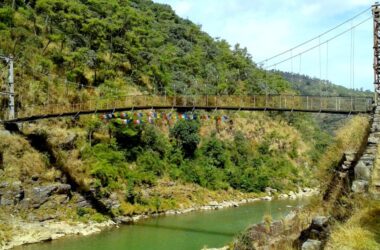Mount Jiuhua: Located in the southeastern part of Anhui province in China, Mount Jiuhua is one of the four sacred mountains of Chinese Buddhism. The mountain range stretches over 120 square kilometers and has an elevation of 1,342 meters above sea level. Mount Jiuhua is renowned for its picturesque landscapes, ancient temples, and spiritual significance, making it a popular destination for both pilgrims and tourists.
In this article, we’ll delve into the history, culture, and natural beauty of Mount Jiuhua, including its significance in Chinese Buddhism, the major temples and shrines on the mountain, and the unique flora and fauna that can be found in the region.
The History of Mount Jiuhua
Mount Jiuhua has been a place of pilgrimage for Buddhists for over a thousand years. It is said that in the Tang Dynasty (618-907), a monk named Qixia traveled to the mountain and built a small temple. Since then, many other temples and shrines have been constructed, turning the area into a holy site for Buddhists.
In the early 20th century, the mountain was heavily damaged by wars and political turmoil. It wasn’t until the 1980s that the government began to invest in the restoration of temples and the preservation of the natural environment. Today, Mount Jiuhua is not only a place of religious significance but also a UNESCO World Heritage site and a popular destination for travelers looking to immerse themselves in Chinese culture.
The Spiritual Significance of Mount Jiuhua
Mount Jiuhua is home to more than 90 temples and shrines, many of which are still in use today. The most famous of these is the Huacheng Temple, which is located at the foot of the mountain and is the main entrance to the scenic area. Huacheng Temple was first built in the Tang Dynasty and has been renovated several times over the years. It is known for its imposing architecture, intricate carvings, and beautiful gardens.
Another major temple on the mountain is the Tiantai Temple, which was built in the Song Dynasty (960-1279). The temple is dedicated to the Tiantai sect of Buddhism, which emphasizes the importance of meditation and the Lotus Sutra. The Tiantai Temple is famous for its Thousand-Buddha Hall, which houses more than 2,000 statues of Buddha, as well as its ancient pagoda and peaceful surroundings.
The Zhiyuan Temple is also worth a visit, as it is one of the oldest and most revered temples on the mountain. The temple was first built in the Tang Dynasty and has undergone several renovations and expansions over the years. It is home to many precious relics, including a 1,200-year-old stone Buddha statue and a collection of ancient sutras.
The natural environment of Mount Jiuhua is also imbued with spiritual significance. The mountain is known for its “four wonders”: clouds, waterfalls, sunrise, and sunset. The clouds around the mountain are often so thick that they resemble a sea of cotton, creating a serene and ethereal atmosphere. The waterfalls are also a major attraction, with the most famous being the Huatai Waterfall, which is over 200 meters high and is said to resemble a white silk ribbon.
The Flora and Fauna of Mount Jiuhua
Mount Jiuhua is not only a spiritual and cultural center but also a treasure trove of biodiversity. The mountain is covered with dense forests, which are home to a wide variety of plant and animal species. There are over 2,000 species of plants on the mountain, including many rare and endangered species, such as the Jiuhua Snow Lotus and the Jiuh Hua Pine. The mountain is also home to a rich variety of wildlife, including over 300 species of animals, such as the golden pheasant, the leopard, and the black bear.
The forests on Mount Jiuhua are not only home to a diverse array of flora and fauna, but also to many scenic hiking trails. Visitors can explore the mountain’s natural beauty by trekking through the forests, stopping to admire the waterfalls, and marveling at the stunning vistas from the mountaintops.
One of the most famous hikes on the mountain is the Sunrise Trail, which leads visitors to the highest peak on Mount Jiuhua, Shiwang Peak. The trail starts early in the morning, so hikers can witness the spectacular sunrise over the sea of clouds. Another popular trail is the Huatai Trail, which takes visitors to the Huatai Waterfall, one of the most impressive waterfalls in the region.
Visiting Mount Jiuhua
Visiting Mount Jiuhua is an experience that will stay with you for a lifetime. The mountain offers something for everyone, whether you’re a spiritual seeker, a nature lover, or a culture enthusiast. If you’re planning a trip to Mount Jiuhua, here are some tips to help you make the most of your visit:
- Plan ahead: Make sure to research the best time to visit and plan your trip accordingly. The best time to visit Mount Jiuhua is from April to November when the weather is mild and the foliage is at its most colorful.
- Dress appropriately: Wear comfortable shoes and clothing suitable for hiking, as there are many trails to explore on the mountain. It’s also a good idea to bring a jacket or sweater, as the weather can be cool, especially in the early morning and evening.
- Respect the culture: Mount Jiuhua is a sacred site for Buddhists, so it’s important to respect the culture and traditions of the area. Dress modestly and avoid making loud noises or engaging in disruptive behavior while visiting the temples.
- Try the local cuisine: Anhui province is known for its unique cuisine, which features a variety of local specialties, such as stinky tofu, braised bamboo shoots, and Anhui-style chicken. Be sure to sample some of the local dishes while you’re in the area.
In conclusion, Mount Jiuhua is a true gem of Anhui province and one of the most beautiful and spiritual places in China. From the ancient temples to the stunning natural beauty of the mountain, a visit to Mount Jiuhua is a truly unforgettable experience. Whether you’re seeking spiritual enlightenment or just looking for a peaceful escape from the hustle and bustle of everyday life, Mount Jiuhua is the perfect destination for anyone who loves culture, nature, and adventure.
Similar Articles
- Hongcun Village: A Timeless Gem in China
- Huangshan Mountain: Discover the Beauty
- Anhui: Exploring the Wonders
Frequently Asked Questions About Mount Jiuhua
Q. What is Mount Jiuhua?
A – Mt Jiuhua is a mountain range located in Anhui province, China. It is a sacred site for Buddhists and is home to many temples and monasteries.
Q. Why is Mount Jiuhua important to Buddhists?
A – This is one of the four sacred mountains in Chinese Buddhism, along with Mt Wutai, Mt Putuo, and Mount Emei. It is believed to be the dwelling place of Ksitigarbha Bodhisattva, who is regarded as the protector of the dead.
Q. What is the best time to visit Mt Jiuhua?
A – The best time to visit is from April to November when the weather is mild and the foliage is at its most colorful.
Q. Are there any hiking trails on Mount Jiuhua?
A – Yes, there are many hiking trails on Mt Jiuhua, including the Sunrise Trail and the Huatai Trail. These trails offer stunning views of the mountain and its surrounding scenery.
Q. What is the Huacheng Temple on Mount Jiuhua?
A – Huacheng Temple is one of the most important temples on Mt Jiuhua. It was built in the Tang dynasty and is famous for its stunning architecture and beautiful sculptures.
Q. Is it possible to stay overnight on Mount Jiuhua?
A – Yes, there are many hotels and guesthouses on Mt Jiuhua where visitors can stay overnight. Some of these accommodations are located near the temples and offer stunning views of the mountain.
Q. What is the nearest airport to Mount Jiuhua?
A – The nearest airport to Mt Jiuhua is Huangshan Tunxi International Airport, which is located about 100 kilometers away. From the airport, visitors can take a bus or hire a taxi to get to Mount Jiuhua.
Q. Is it necessary to hire a tour guide to visit Mount Jiuhua?
A – It is not necessary to hire a tour guide to visit Mt Jiuhua, but it can be helpful if you want to learn more about the history and culture of the area. Many tour guides are knowledgeable about the temples and hiking trails on the mountain and can offer valuable insights.
Q. Is there an admission fee to enter the temples on Mount Jiuhua?
A – Yes, there is an admission fee to enter the temples on Mt Jiuhua. The cost varies depending on the temple and the season, but it is generally around 100 yuan ($15 USD) per person.
Q. Are there any restrictions on photography on Mount Jiuhua?
A – Photography is generally allowed on Mt Jiuhua, but there may be some restrictions in certain areas, such as inside the temples. It’s important to respect the rules and regulations of the area and not take photos where it is not permitted.









